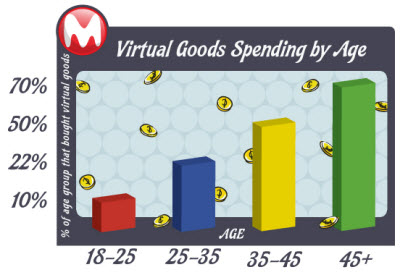 The older you are, the more likely you are to buy virtual goods in mobile social games. That’s the conclusion of a survey by mobile gaming community MocoSpace.
The older you are, the more likely you are to buy virtual goods in mobile social games. That’s the conclusion of a survey by mobile gaming community MocoSpace.
The report found that gamers aged 25 to 35 spend the most time playing social games on mobile devices, but gamers over 45 spend exponentially more on virtual goods than their younger counterparts. The three-month survey polled nearly 500,000 gamers on Boston-based MocoSpace’s network of 22 million users.
Age correlates directly with the amount of money spent on virtual goods in social games. Gamers over 35, who made up 18 percent of those surveyed, were responsible for 42 percent of virtual goods purchases. By comparison, gamers aged 18 to 25, who were 43 percent of those surveyed, were responsible for only 18 percent of the purchases.
The 25- to 35-year-old demographic is by far the most active in social gaming. Players in this age group spent nearly twice as much time gaming as any other group, but only 22 percent of them bought virtual goods. Those 45 and older spent the least amount of time playing games, but 70 percent of them bought virtual goods. It makes sense because older demographics have more disposable income, and younger people have more disposable time on their hands.
AI Weekly
The must-read newsletter for AI and Big Data industry written by Khari Johnson, Kyle Wiggers, and Seth Colaner.
Included with VentureBeat Insider and VentureBeat VIP memberships.
 “We’re seeing parents go from spending money on buying games for their kids, to spending money on virtual goods in games for themselves,” said Justin Siegel, chief executive of MocoSpace.
“We’re seeing parents go from spending money on buying games for their kids, to spending money on virtual goods in games for themselves,” said Justin Siegel, chief executive of MocoSpace.
The results also suggest that different monetization methods may work for different age groups. If younger gamers spend the most time in games, an ad-based model may be more profitable than a purely virtual goods-based approach.
VentureBeat's mission is to be a digital town square for technical decision-makers to gain knowledge about transformative enterprise technology and transact. Learn More